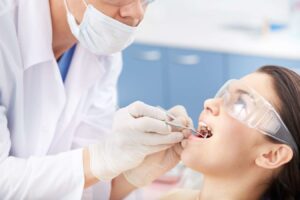What is it?
Dental cleanings, also known as prophylaxis or teeth cleaning, are essential preventive dental procedures performed by dental hygienists or dentists to maintain optimal oral health. These cleanings remove plaque, tartar, and stains from the teeth, preventing the development of dental problems such as cavities, gum disease, and bad breath.
Here’s an overview of dental cleanings and their key aspects:
- Purpose of Dental Cleanings:
- Plaque Removal: Plaque is a sticky film of bacteria that forms on the teeth and along the gumline. Regular cleanings help remove plaque, preventing it from hardening into tartar.
- Tartar Removal: Tartar, also known as calculus, is hardened plaque that cannot be removed by brushing or flossing alone. Dental instruments are used during cleanings to remove tartar buildup, reducing the risk of gum disease.
- Stain Removal: Dental cleanings can remove surface stains caused by factors such as smoking, coffee, tea, or certain foods, resulting in a brighter and more attractive smile.
- Prevention of Dental Problems: By removing plaque and tartar, dental cleanings help prevent the development of cavities, gingivitis (gum inflammation), periodontitis (gum disease), and other oral health issues.
- Procedure:
- Evaluation: Before the cleaning, the dental hygienist or dentist will perform a thorough examination of the teeth and gums to assess the overall oral health and identify any areas of concern.
- Scaling: Using specialized dental instruments, the hygienist will carefully remove plaque and tartar deposits from the tooth surfaces, including below the gumline.
- Polishing: After scaling, the teeth are polished using a rotating brush or rubber cup attachment and a mildly abrasive toothpaste. This helps remove surface stains and smooths the tooth surfaces, making it more difficult for plaque to adhere.
- Fluoride Treatment: Some dental cleanings may include the application of fluoride gel or varnish to strengthen tooth enamel and provide additional protection against cavities.
- Education: Throughout the cleaning appointment, the dental hygienist or dentist may provide oral hygiene instructions and tips for maintaining good oral health at home, including proper brushing and flossing techniques.
- Frequency of Dental Cleanings:
- The American Dental Association (ADA) recommends regular dental cleanings every six months for most individuals. However, some people may require more frequent cleanings based on their oral health needs, such as those with a history of gum disease or high risk of cavities.
- Patients should follow their dentist’s or hygienist’s recommendations regarding the frequency of dental cleanings to ensure optimal oral health.
- Benefits of Dental Cleanings:
- Prevention of Dental Problems: Regular cleanings help prevent the development of cavities, gum disease, and other oral health issues, saving time and money on more extensive dental treatments in the future.
- Improved Oral Hygiene: Dental cleanings complement daily brushing and flossing efforts by removing plaque and tartar buildup that cannot be eliminated with regular home care alone.
- Fresh Breath: Removing plaque and tartar buildup helps eliminate bacteria that can cause bad breath, resulting in a fresher and more pleasant breath.
In summary, dental cleanings play a crucial role in maintaining optimal oral health by removing plaque, tartar, and stains from the teeth, preventing the development of dental problems, and promoting a healthy smile. Regular cleanings, combined with good oral hygiene practices at home, are essential for achieving and maintaining a healthy mouth for life.

